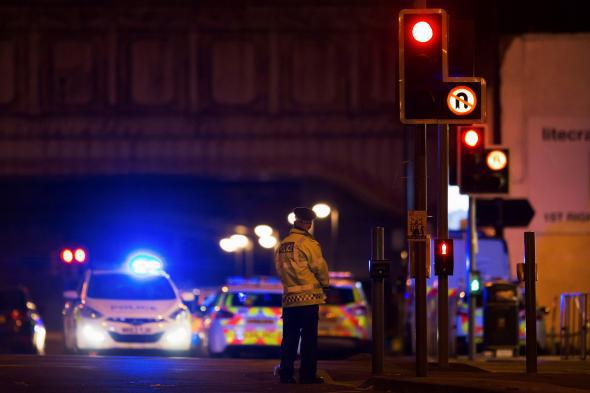As news broke Monday night of the deadly blasts at a concert in Manchester, England, you could flip to any major news network and see similar visuals: shaky cellphone videos of people on the scene—many of them teenage girls—screaming and running for their lives. CNN and Fox News, in particular, seemed to play the same videos again and again, etching the haunting details into the memory of anyone watching for an extended period of time.
This element of the broadcasts was hardly novel: Scenes of chaos and panic are a staple of cable news coverage of terror attacks, from September 11 to Paris to Orlando. Periodically, media critics will point out that this sort of treatment—which emphasizes the drama, the human suffering, the terror itself—tends to serve the goals of the perpetrators. It helps to elevate a local tragedy to a global one, and to magnify the public’s fear and anger exponentially. In the long run, it may help to perpetuate a cycle of violence, of nonstate terror and state retribution.
That critique seemed to pick up momentum Monday night on Twitter. The professor and technology critic Zeynep Tufekci advanced it, as she has in the past.
This time, more than usual it seemed, mainstream ears pricked up, as even the center-right MSNBC host Joe Scarborough retweeted and amplified her message.
On a night when the pain ran deep but scapegoats were hard to come by—ISIS hadn’t yet claimed responsibility for the attack—cable news producers seemed to run a close second to that guy who tweeted the bad joke as the villains of the night.
But was the backlash warranted?
In the grand scheme, the critics are no doubt right that graphic TV coverage of terror attacks plays into terrorists’ hands. And in this specific instance, the persistent replaying of shaky footage of screaming teenagers carried an extra whiff of unseemly sensationalism on the networks’ part. On the margins, there was room for the coverage to be more discrete and respectful of the victims.
But there’s also a ring of naiveté to suggestions that the answer is for cable news to simply stop playing such footage. TV producers aren’t the ones who made the attacks scary or dramatic. That’s the nature of the act, and to try to strip that dimension from the news coverage would verge on the dishonest and unjournalistic.
Likewise, in 2017 cable news isn’t driving the intense public interest in coverage of terror attacks. It’s responding to it. If CNN or Fox News didn’t air frightening footage, it would surely go viral on YouTube and any number of other social media outlets. That’s not to say major media outlets bear no responsibility for their decisions. But even if we stipulated that suppressing or downplaying public interest in footage of terror attacks were within their purview, it simply is not within their power. Terror attacks are news, and the terror they cause is part of the story.
In particular, the notion that the problem lies in playing these videos “on loop” misconstrues the nature of the medium. Cable news networks don’t play the clips again and again in order to bludgeon viewers who’ve already seen them five times. They do it, at least in part, because new viewers are constantly tuning in to see them.
I’m sympathetic to the view that the media, and cable news in particular, could do a better job covering terror attacks in proportion to the damage they inflict. The challenge of how to fill 24 hours of screen time each day leads to all sorts of knotty editorial decisions, and the endless rehashing of terror attacks that killed a few people, or even a few dozen, is among them. Contrast it with the coverage of, say, the March floods in Peru—which killed more than 100, destroyed some 14,000 homes, and left 150,000 people homeless, according to the New York Times—and it’s easy see the discrepancy. If you found yourself wondering, what March floods in Peru?, then Q.E.D. The problem here isn’t just the coverage’s tone or substance, but its extent. And it isn’t limited to cable news.
But on Monday night, for once, at least two of the major networks actually didn’t seem to drastically overplay the Manchester attacks. CNN and MSNBC interspersed their breaking news coverage with plenty of political coverage, including the ongoing sagas of Trump’s overseas trip and Russia ties. And by Tuesday morning, political coverage had already regained center stage. Granted, this would likely have been different had the attack been in the United States, or perhaps even a global capital such as Paris. And the balance probably had more to do with the urgency of the ongoing Trump story than with any great act of conscience on CNN or MSNBC’s part.
Only Fox News so far has really labored to ensure that Manchester dominates the agenda, and that can hardly come as a surprise. The network has been so loath to focus on Trump’s scandals that in recent days it had resorted to outrageous conspiracy-mongering as a diversionary tactic. The Manchester attack at last provided Fox News’ Trump loyalists with a plausible alternative, and they seized it.
